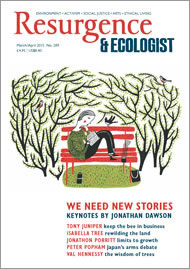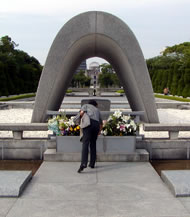Japan is probably the only major nation in the world that has voluntarily renounced the right to wage war.
Seen through the eyes of realpolitik, Article 9 of Japan’s post-war constitution, signed into force in May 1947, reads like a rash, even naive declaration. “Aspiring sincerely to an international peace based on justice and order,” it goes, “the Japanese people forever renounce war as a sovereign right of the nation and the threat or use of force as means of settling international disputes… [L]and, sea and air forces, as well as other war potential, will never be maintained. The right of belligerency of the state will not be recognized.”
What kind of world did Japan’s post-war leaders imagine they were living in? How did they think their country could survive without an army?
The simple answer is, of course, that Article 9 was not a Japanese idea. It was imposed on Japan’s government by the Occupation authorities, overwhelmingly American. Many Japanese of the ruling class accepted it as they accepted everything else the Yankees brought with them, through gritted teeth. They had no choice in the matter. The nation was on its knees.
Yet here is the strange thing: more than 67 years later, Article 9 endures, despite powerful and persistent conservative pressure to discard it.
The most determined effort to roll back Japanese pacifism has come from Shinz? Abe, the prime minister, who in mid-December 2014 won a second successive general election victory. An unreconstructed nationalist, he follows the line of other conservative politicians down the years. He wants Japan to rewrite the history books that blame the Pacific War on Japanese pre-war belligerence, that draw attention to such horrors as the Nanking massacre and the enslavement of Korean and other women as prostitutes serving the military, the so-called comfort women. He has also told his co-nationals that it is time Japan threw off the burden of war guilt and stood strong and armed in the world again. On 16 December, one day after winning the election, he reiterated his and his party’s long-term goal of revising the pacifist constitution to allow this to happen.
What is remarkable is not that a Japanese leader says such things – after all, this is still the third-strongest economic power in the world after the US and China. With China growing notably more aggressive in pushing its claims in the East and South China Seas, Japan feels under pressure from its giant neighbour as never before.
No, what is remarkable is the difficulty Abe has had in persuading his compatriots to follow his lead.
Many conservatives, Abe included, would like to junk Article 9, consign it to the dustbin of history. Forget it ever existed. Transform Japan once more into a major military power, indeed a nuclear power. But instead of trying to revise the constitution, which would require a two-thirds majority in both houses of parliament and a majority in a nationwide referendum, in July 2014 he merely ruled that the article be re-interpreted to give Japan a limited right to collective self-defence. And even this was deeply unpopular. The will of the nation was against it.
Why are the Japanese so reluctant to re-arm?
The simple answer is, bitter experience.
Japan’s militaristic years before the second world war saw the nation indoctrinated with the ideology of imperialism, the racial superiority of the Japanese, and the mystical certainty of their ability to destroy their enemies. Intoxicated by this certainty, the regime precipitated the Pacific War by bombing Pearl Harbor. Their forces poured through South East Asia, elbowing the Dutch, French and British colonialists aside with ease.
But the whole enterprise was built on rotten foundations. Within two years the troops were running out of weapons and food. The army was running out of airplanes and artillery. In place of arms, the military regime evoked the spiritual oneness of the nation, “a hundred million hearts beating as one”. The original kamikaze, a typhoon that blew up and destroyed the invading fleet of the Mongols in the 13th century, was evoked as a principle of national invulnerability. Translated into modern terms, it meant an entire nation ready and willing to die for their emperor.
The tokkotai, the notorious Kamikaze air corps that terrorised Allied fleets, was only the most elite of these forces. Young flyers were trained to crash the only remaining serviceable aircraft, Gipsy Moth-type biplanes, into invading Allied ships. Pint-sized naval recruits were taught how to crash their miniature submarines into the hulls of Allied destroyers. Men who were too old or disabled for active service were given explosives and hammers and ordered to dig holes on the beaches and squat inside them when the enemy’s amphibious vessels approached, ready to blow themselves up at the right moment.
The surrender, after the Allied destruction of every major Japanese city except Kyoto, was a national trauma. Everything the Japanese had been brainwashed into believing stood exposed as a lie – starting with the myth of national inviolability.
When the foreign occupiers ordered them to renounce war, the traumatised Japanese saw every advantage to the proposal. After all, they had been there before.
In the 16th century, the second of Japan’s three great medieval shoguns, Hideyoshi, conceived a plan just as bold, for its day, as that of Japan’s 20th-century imperialists. It prefigured Pear Harbor in both ambition and hubristic folly: he would invade Korea, China and the Philippines. He would start with Korea, the closest part of the continent.
Japan at the time was bristling with weapons, and growing conscious for the first time of its military potential. This had been noticed by the most perceptive of the foreign visitors to the country, the Jesuit missionaries, who wanted to convert the Japanese to Christianity. The most famous of them, Francis Xavier, wrote in 1552, “[The Japanese] prize and honour all that has to do with war… and there is nothing of which they are so proud as of weapons adorned with gold and silver. They always wear swords and daggers, both in and out of the house, and when they go to sleep they hang them at the bed’s head. In short, they value arms more than any people I have ever seen.”
Hideyoshi invaded the Korean peninsula with ease, bringing 160,000 troops, a quarter of them armed with matchlocks. Guns had been introduced to Japan by Portuguese seamen only nine years before. When the local lord saw one of them shoot a duck with his arquebus, he quickly grasped the weapon’s potential and ordered his blacksmith to make a copy. Within a decade, gunsmiths all over Japan were turning out guns in large numbers, and tens of thousands were deployed in Hideyoshi’s invasion.
But like imperial Japan’s crazed attempt to defeat the US, Hideyoshi’s ambition was soon drenched in the cold water of reality: Chinese forces came to Korea’s aid and drove the invaders back down the peninsula. Japan had learnt a painful lesson. She withdrew to her island confines, expelled the Europeans, and closed the country to outsiders. And gradually, over a period of decades, the Japanese people also turned their back on guns – the barbarous weapons that had fed their hubristic plan to conquer China. Instead they reverted to the sword: the embodiment of samurai honour and artisan workmanship, the essential tool for fighting a duel, but of no use at all in conquering the world.
With the closure of the country began the 265-year period known as “a peaceful state”. The arts flourished, the economy quietly boomed, the guns fell silent. When the outside world in the form of Commodore Perry forced Japan to open again to the outside world in 1852, his sailors laughed at the antiquated little brass cannons that peered out from the shore batteries, none less than 230 years old.
With the reopening of the country, Japan’s new era of glory and misery got under way. It culminated less than a century later with the atom bombing of Hiroshima and Nagasaki. Then, with the surrender, a new era of peace was thrust upon them by the victors. We should not be surprised that they welcomed it so warmly.








